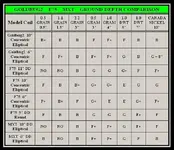Jim Hemmingway
Hero Member
Hi Everyone…
I wondered if you guys would like to see some VLF ground depth test results over a range of target sizes. These results may differ from what you experience over your ground…
The purpose of the chart below is to present relative, side-by-side depth comparisons over freshly buried nickels and lead “nuggets”. The soil here ground balances at GB86 with a Fe3O4 bar graph readout at 0.3% equivalent magnetite using the F75's 10” elliptical concentric…on the steeper side of moderate ground mineral magnetic strength.
The 0.5 and 1.1 grain lead “nuggets” are solid and compact shaped, whereas the other test pieces are oval-shaped and reasonably flat. All units were tested in the motion all-metal mode, maximum gain (and max Goldbug2 volume), and a neutral ground balance. The Goldbug2 was run at “low mineral” setting for best signal response. The chart designations B = barely F = fair G = good E = excellent… refer to signal strength.
As freshly buried disturbed ground targets, these test targets do not signal as well as can be expected from targets that have naturally settled into undisturbed ground over many years. High residential EMI made it difficult to assess small or deep target signals when using high gain settings on the MXT. Small coils are more stable under such conditions, and produce more distinct signals.
The results are pretty much what we would expect. Small coils are relatively quiet and stable because they see less EMI and ground mineral. They see small targets better than larger coils, but don’t see as deeply on larger targets. DD coils have no apparent depth advantage in this soil, despite that they see less ground mineral. Slight differences between various targets and coils are indicated with “+” signs in the chart.
The chart results do not account for the “distinctness” of a signal. Despite generally lesser signal strength over these targets, the GB2 produces a more distinct or discrete signal over the 0.5 and 1.1 grain targets than did the stronger but less discrete F75 signal. The GB2 hits on these targets even with the sensitivity significantly reduced, whereas the F75 is highly gain dependent on the very small stuff.
The MXT result over the 0.5 grain piece using the 6” shooter coil is “soft” because some days no signal could be had at all. MXT was ground balanced and GB locked prior to testing.
Jim.
I wondered if you guys would like to see some VLF ground depth test results over a range of target sizes. These results may differ from what you experience over your ground…
The purpose of the chart below is to present relative, side-by-side depth comparisons over freshly buried nickels and lead “nuggets”. The soil here ground balances at GB86 with a Fe3O4 bar graph readout at 0.3% equivalent magnetite using the F75's 10” elliptical concentric…on the steeper side of moderate ground mineral magnetic strength.
The 0.5 and 1.1 grain lead “nuggets” are solid and compact shaped, whereas the other test pieces are oval-shaped and reasonably flat. All units were tested in the motion all-metal mode, maximum gain (and max Goldbug2 volume), and a neutral ground balance. The Goldbug2 was run at “low mineral” setting for best signal response. The chart designations B = barely F = fair G = good E = excellent… refer to signal strength.
As freshly buried disturbed ground targets, these test targets do not signal as well as can be expected from targets that have naturally settled into undisturbed ground over many years. High residential EMI made it difficult to assess small or deep target signals when using high gain settings on the MXT. Small coils are more stable under such conditions, and produce more distinct signals.
The results are pretty much what we would expect. Small coils are relatively quiet and stable because they see less EMI and ground mineral. They see small targets better than larger coils, but don’t see as deeply on larger targets. DD coils have no apparent depth advantage in this soil, despite that they see less ground mineral. Slight differences between various targets and coils are indicated with “+” signs in the chart.
The chart results do not account for the “distinctness” of a signal. Despite generally lesser signal strength over these targets, the GB2 produces a more distinct or discrete signal over the 0.5 and 1.1 grain targets than did the stronger but less discrete F75 signal. The GB2 hits on these targets even with the sensitivity significantly reduced, whereas the F75 is highly gain dependent on the very small stuff.
The MXT result over the 0.5 grain piece using the 6” shooter coil is “soft” because some days no signal could be had at all. MXT was ground balanced and GB locked prior to testing.
Jim.
Amazon Forum Fav 👍
Upvote
0





